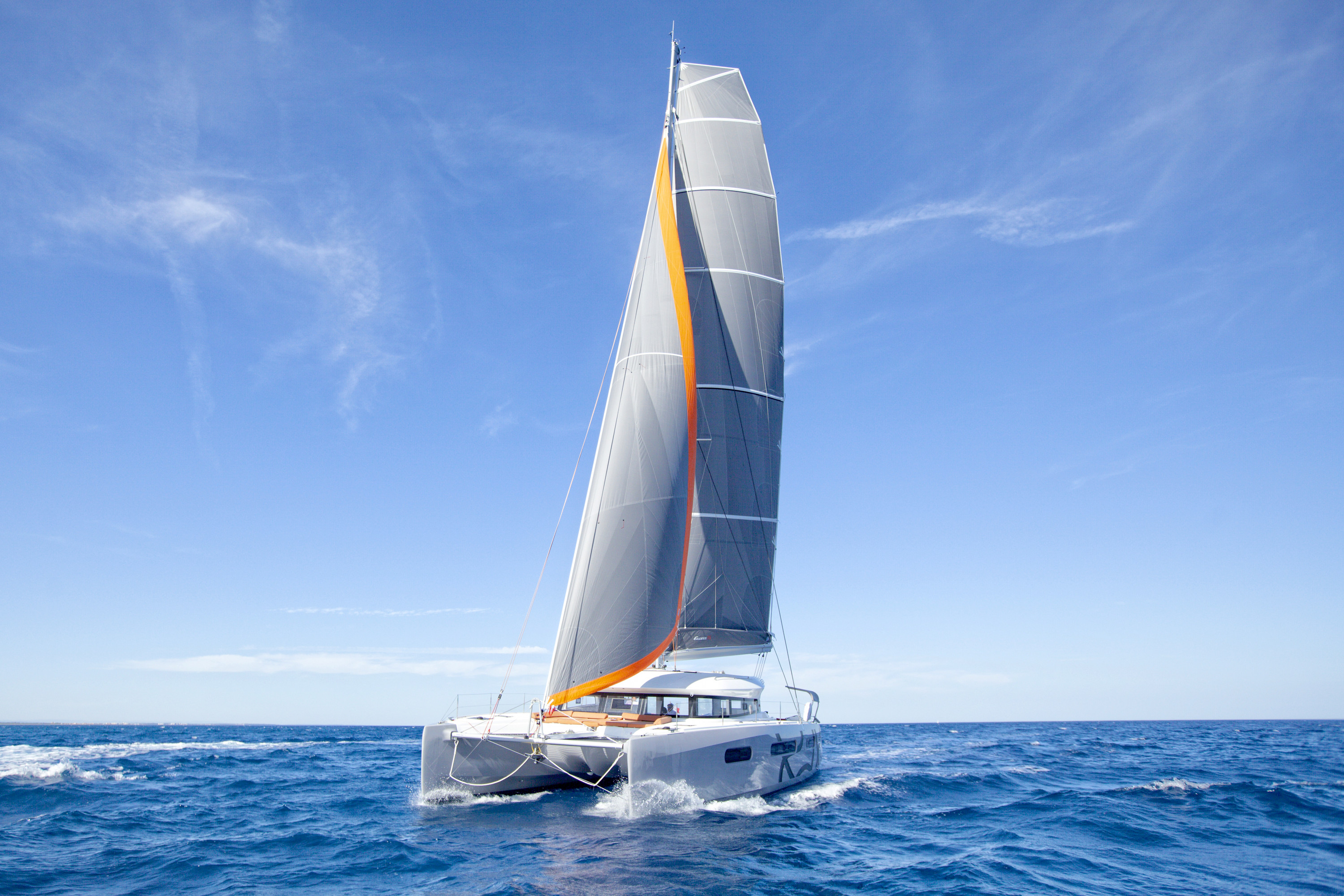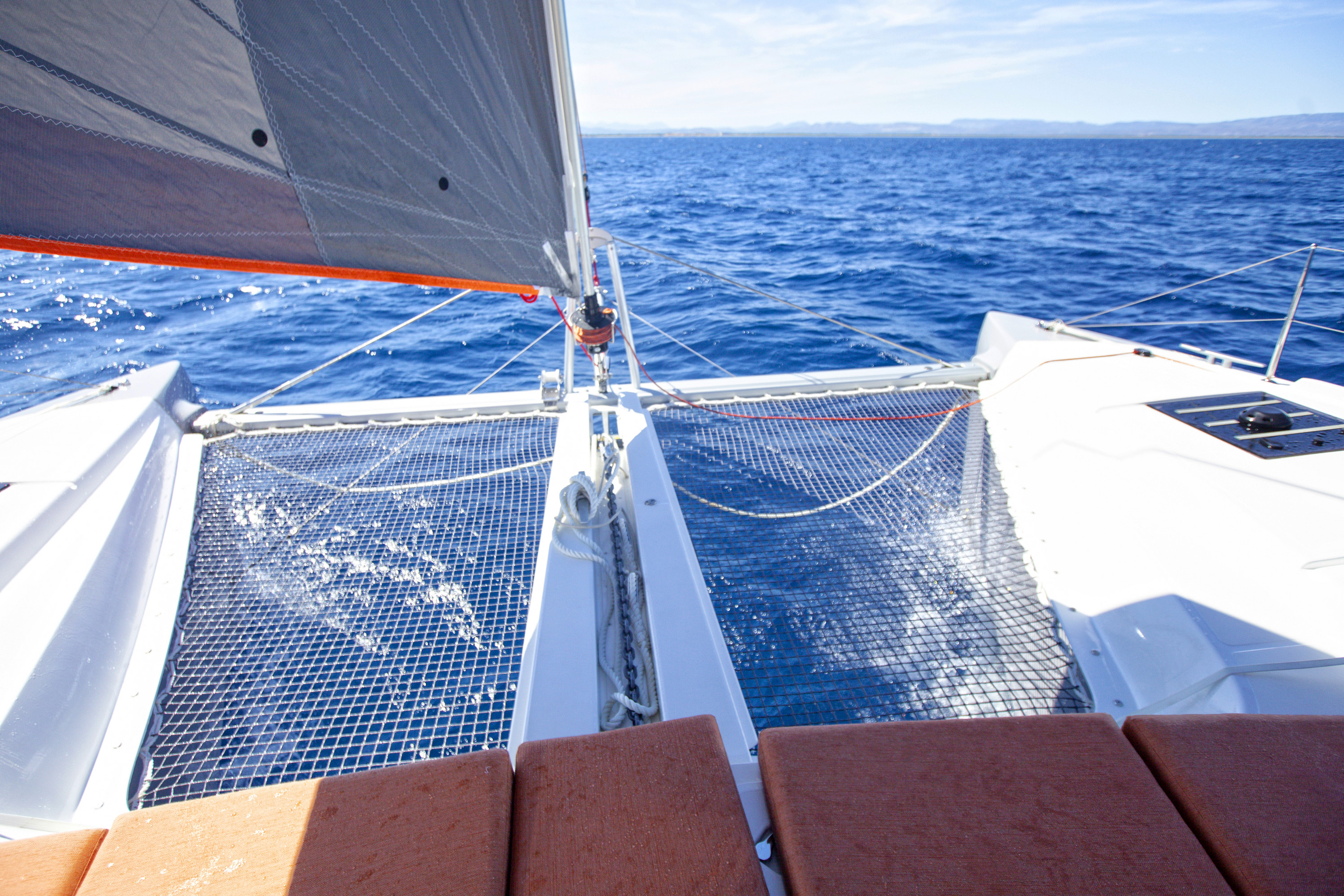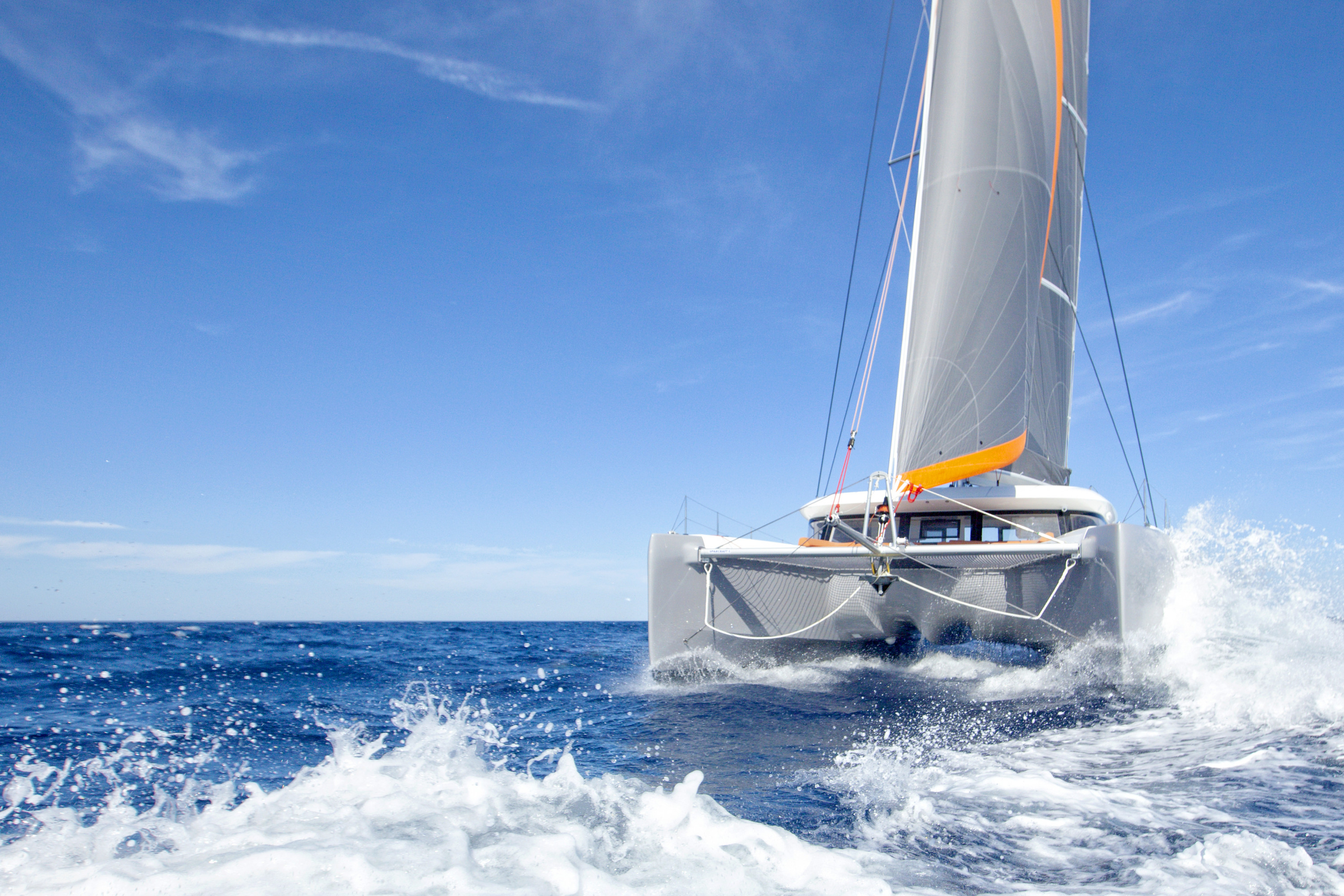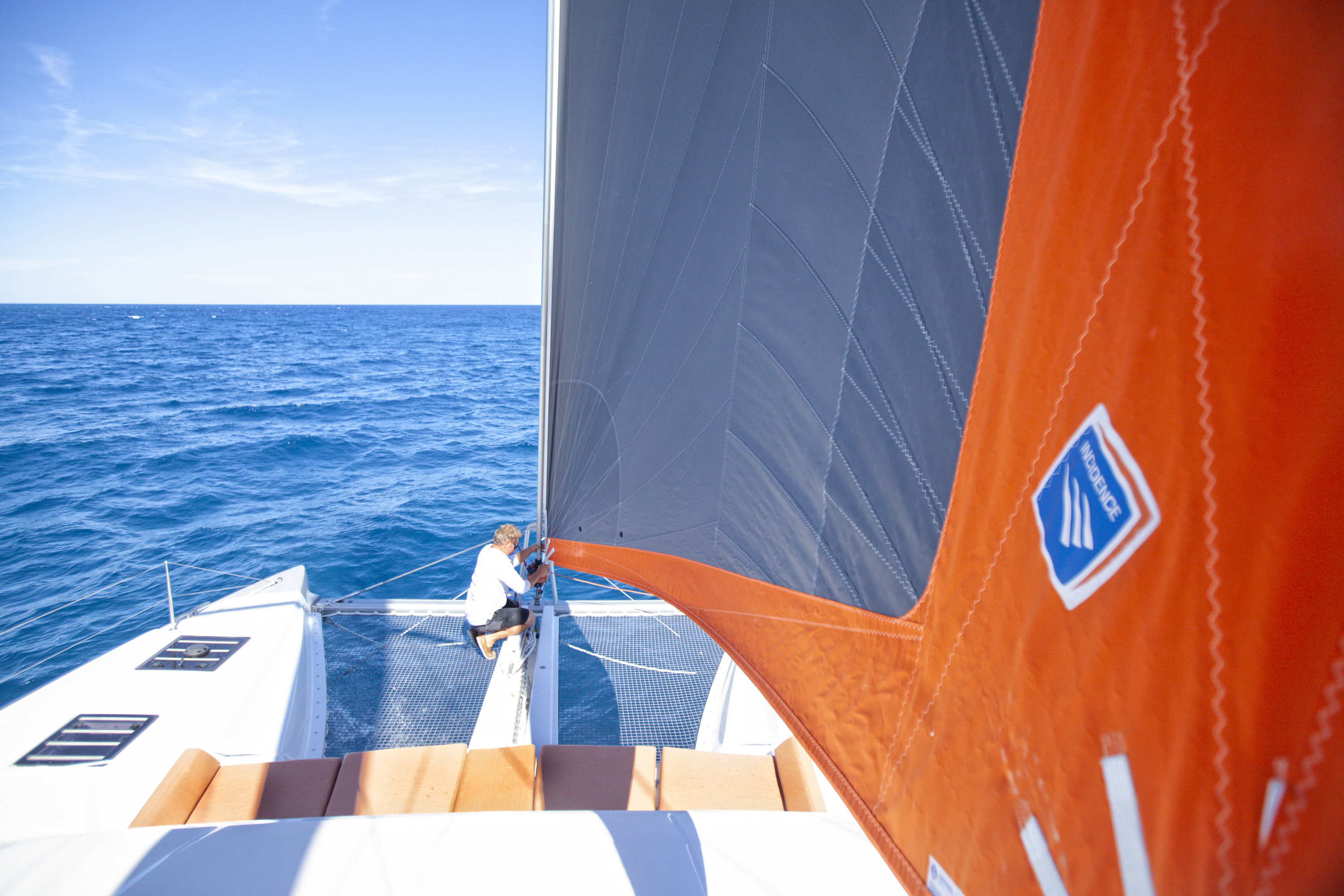As an Amazon Associate, we earn from qualifying purchases. We may also earn commissions if you purchase products from other retailers after clicking on a link from our site.
When people see a catamaran, many think of capsizing, which has proven to be a way less common event than your average forum thread would lead you to believe. This article will use a scientific approach to look at the data available for stability incidents with catamarans.
This article is based on a study made by the UK government concerning recommendations for regulating catamarans. I have used that knowledge to discuss some of the common misunderstandings considering catamaran stability. Let’s get to the short answer!
A Catamaran will capsize when rotational forces overcome the stability of the boat. Capsizing can happen in two ways, either the ship overtakes a wave and sinks it bows into the next one, inducing something called pitch-poling. Or a breaking wave, with the same height as the boat’s length, hits the vessel’s side, making it roll over to its side(a.ka. flipping).
Are you like me and need to understand why? Read on!
What Does It Mean to Capsize?
In the context of boats, to capsize means to flip the boat upside down unintentionally.
On a small dingy, it is part of the sailing experience, and the boat can quickly be righted, but on a cruising cat, it can be the difference between life and death.
This can happen in numerous ways that will be discussed in great detail below. The most common is a combination of high seas, strong winds, and sailor error.
Not only is it dangerous to be in the middle of the sea stuck on what has now become a very expensive chunk of plastic, but the act of capsizing is also hazardous. Depending on where you are, inside, outside, or in one of the hulls, you may face the risk of getting thrown overboard, stuck in a hull upside down in the dark, or getting hurt by flying objects.
Much of the discussion around capsizing and what to do after it has happened is theoretical. In this article, I will show you the science behind catamaran stability and how that interacts with the power of the sea.
Why Does a Catamaran Capsize?
Catamaran stability can sometimes be a little tricky to understand. To get us off to a good start, here is some terminology that will be useful;
- Wind heeling moment is the effect wind has on the rotational(heeling) movement of the boat.
- Apparent wind angle is the angle of the wind when the boat is moving; this can differ from true wind, which is measured in a fixed position.
The study reaches a couple of conclusions, some of which are of interest to this discussion.

Heeling Is Greatly Dependent on Apparent Wind Angle and Sheeting of the Sails
This means that a catamaran (or any other sailboat, for that matter) will have a greater rotational force if the sails are sheeted in hard. This is because the wind gets “caught” in the sails, and the forces act directly on the sails, mast, standing rigging, and onto the hulls.
If, instead, the sails were loosened or “sloppy,” the amount of wind “caught” would be less, and therefore, more wind would be able to pass around the sails, thus decreasing the heel.
When it comes to apparent wind angle, the study shows that the forces are most significant when the wind is forward of the beam. This is primarily due to the aerodynamic effectiveness decreases aft of the beam.
Large Waves From the Side or Aft
Large waves are always a factor con safety at sea; they can be divided into breaking waves, waves whose amplitude (basically when waves get so big that they start coming apart(breaking) reach a threshold where the shape of the waves suddenly changes.
The other category is non-breaking waves or rolly waves. These are more gentle and cannot change shape in a violent and uncontrolled manner.
The study concludes that (1)catamarans have less roll response than monohulls during non-breaking waves, which means a catamaran will generally follow the motion and wave shape as it goes up and down it in a predictable manner, and that (2) this behavior shows no indications of being dangerous.
A monohull will instead rock from side to side and show a pendulum-like behavior.
On the other hand, breaking waves pose a real threat and are something to be aware of if traveling on a smaller catamaran. The test showed that a sufficient beam-to-wave ratio is needed to avoid capsizing.
A common beam-to-length ratio is 50%; that is, the length of the boat is at least double the size of its width.
Together with wind forces, breaking waves seem to be the most significant factor affecting the risk of capsizing.
Breaking waves with a height equivalent to the beam of a catamaran, half the beam of a trimaran may be sufficient to cause a capsize. Smaller or narrower yachts are, therefore, more vulnerable.
What makes breaking waves dangerous is their ability to bring the boat past its tipping point (or range of stability); much of this is due to the steepness of the wave. A 30ft non-breaking wave will act as a rolling hill in the English countryside, while a 15ft breaking wave is more of a black slope in a French ski resort.
The closer a boat comes to its tipping point, the less energy is needed to move past it. This is why the combination of factors is essential, large breaking waves, high apparent wind forward of the beam, and a minor error from the cockpit, and disaster is around the corner.
Effect of Keels (Daggerboards, Centerboards)
When a catamaran is hit with a breaking wave from its side, one factor that reduces rotational forces is the ability to move sideways with the wave, in other words, to slide sideways.
Usually, this is not wanted since it reduces the cat’s ability to go windward; this issue is sometimes addressed by adding mini keels, dagger, or centerboards.
The issue with keels is that the crew cannot withdraw them into the hull to reduce drag; this means that they can become a security issue when hit by large breaking waves to the side. It will hinder the sideways sliding actions and increase the risk of capsizing, as the study indicates.
Here’s an article I wrote comparing daggerboards to centerboards.
Placement of Weight (Vertical Center of Gravity, Vcg)
We have already discussed the importance of having a big enough beam to create sufficient stability. Moving the hulls wider apart will lower the center of gravity (or center of weight) and increase stability; this is true if all other factors are the same.
If we move the hulls closer to each other, the catamaran becomes narrower, and the center of gravity will move upwards. What happens then? You guessed it, removing the wide base makes it less stable and more prone to heeling.
The same effect can be had by moving weight on the ship vertically (VGC); lower = more stable, and vice versa (a monohull moves it below the surface using a heavy keel).
Pitchpoling (Frontflip)
Pitchpoling is when a catamaran sails with the winds and waves, and the speed of the boat increases to levels above the wave speed. When this happens, there is a risk that the catamaran will semi-surf down the wave and hit the next one. This will slow the boat down, increase apparent wind, and create a rotational force that will make the boat invert if big enough.
Pitchpoling can happen in two ways, symmetrically or asymmetrically. According to the testing in the study, it is more common for one of the bows to dig down into the water and then diagonally flip.
Factors That Affect Pitchpoling
Weight
To increase the rotational forces needed for pitchpoling to happen, the center of weighing needs to be shifted aft. This means that a catamaran that is improperly balanced, for example, the bows filled with gear instead of empty, will increase the risk of burying the bows and potentially flipping over. More on weigh issues below!
Another way to offset your balance is to allow water inside the bows; this can happen after repeated slamming of waves onto the hatches. Once filled up, they can hold tons of water and be a severe threat due to buoyancy loss and shift in the center of weight.
Speed
Surfing a wave is cool, but it is much safer to lower the speed through reefing early; this reduction in speed makes it less likely to sail into the next wave or trough and risk pitchpoling.
If the boat speed is still too high, the next option is to deploy a drogue that will break the boat and add some directional stability. If this, for some reason is not possible, the study suggests that the vessel should hit the waves head-on.

Trampolines
We have already discussed the issue of burying the bows; the effect is massively increased with a solid deck that almost makes the boat into a spoon(a terrible thing if you do want thousands of kilos of water onboard). A better way to dissipate water is with trampolines that lets the water through in a much faster way, like eating soup with a fork.
The effect of having trampolines is twofold; firstly, it will reduce the time the bows are submerged. Secondly, it will decrease the weight of the water on top of the bows and, therefore, how deep the bows will dive.
What is a trampoline on a catamaran?

Hull Shape and Freeboard
There is a discussion that too narrow hulls can increase pitchpoling risk since the hulls might easier dive into the water. I understand the logic, but I am unavailable to find any data to support that claim.
You could also make the claim that wider hulls would increase the braking effect and therefore add to rotational forces. As said, we need more data on this!
Freeboard is the distance between the water and the deck; the bigger this is, the less chance of burying the bows, and vice versa. Same here, It makes sense logically, but there are little data to understand what is enough freeboard.
Real Cases of Catamarans Capsizing
Some news sites have reported on catamarans flipping in different parts of the world. Unfortunately, there is not much data, so drawing well-grounded conclusions is hard.
The previously named study mentions only one report of a catamaran capsizing due to waves hitting its side precisely at the moment of breaking. The cat was 9 m long, and the owner had modified the boat by adding keels.
The study consists of a data set of over 120 incidents reported, of which only 33 are catamarans showing that catamaran capsizing is something very uncommon.
The reason for a catamaran sailboat capsizes;
- 28% Gust of wind
- 28% Wind
- 16% wave and wind
- 12% Pitchpoled
- 8% Wave
- 4% Braking Wave
- 4% Flooded
It is also worth noting that most catamaran incidents happened in the range between 6-9 of wind force(Beaufort). Most incidents were on boats smaller than 11m.
News reporting and other articles
While researching this piece, I came across several relevant news articles regarding incidents and a few well-written case studies. I have incorporated these in this article as a point of discussion rather than factual claims. At the bottom of this page, you’ll find the links if you want to read the articles in full length.
2019 Australia, 39ft catamaran capsizes. The daggerboards can be seen and appear to be fully extended; considering the discussion above with keels, daggerboards will decrease the possibility of sideways movement even further. This is also indicated in the study.
There is a discussion on whether or not to leave one daggerboard deployed and one raised, but once again, the discussions of which one and when vary. And I have not been able to find any scientific support for these claims.
2010 Tonga, 57 ft Atlantic catamaran. The crew describes the situation to be very gusty, with winds up to 60kts! A full report on this incident would be very interesting and could really add to the knowledge database. 57ft is a huge ship, but a boat of this size also has a lot of sail area, and during this incident, the autopilot was steering the ship under reefed sails.
A ship of this size should be wide enough to be able to handle some very big waves, and it would be interesting to see whether the crew stuck to the wind charts. I think there is a lesson to be taught here on autopilot and being on the lookout for bad weather.
You should definitely be behind the helm if there is a squall coming so that you are ready to compensate for a change in wind pattern and quickly put in another reef if the initial assessment was wrong.
Chris White, the designer of Atlantic Catamarans shares his thought on this incident;
To summarize:
Chris White of Chriswhitedesigns.com
1) Neither captain thought capsize was even a possibility until way too late
2) Both boats were under autopilot, which had the helm all the way through the capsize
3) The main sheet was never eased or released
Mythbusting!
The first part of this article takes its trustworthiness from a scientific study backed by the United Kingdom government; in this next section, I will use that knowledge to address some common myths and misconceptions.
A Charter Is Harder to Flip Than a Performance Cat.
As far as I understand, this argument is based on the following premises; the charter boat is heavier than the racing cat; therefore, it is more stable. As we have come to understand from above, it is a matter of total kilograms and where it is located.
A low and centered center of gravity means better stability. A cruising cat can easily be weighed in the wrong places due to all the extra gear that is usually brought along, such as generators or extra food for a long passage.
Moving the center of weight forward increases pitchpoling risk, and moving the weight up makes it vulnerable to breaching by breaking waves.
There is no need to believe a cruising cat is safer in that aspect inherently. Another common argument I hear is that the rigging would never be able to flip a fully loaded cruising cat since the standing rigging will break before lifting a hull.
What is standing and running rigging?
In theory, this might be true (I don’t have the data available), but in reality, this is certainly not the case; the data in the study clearly shows that catamarans can flip with their rigging intact.
Taking the combined factors of wind, waves, and the keels’ braking effect, there is not necessarily much force needed on the rigging for the boat to capsize. Yes (once again, in theory), a lighter catamaran will be easier to flip under some circumstances, but I would then argue that is more of a sailor error than due to the boat’s construction or weight.
Capsizing a Catamaran vs. Monohull
These two types of boats work in very different ways when it comes to stability; one significant factor is the ability of self-righting of a monohull due to its large and heavy keel.
On the other hand, the catamaran will stay bottom-up and mast down until intentionally righted by another ship.
Once the monohull starts leaning to its side, it will start to dissipate the pushing force that the wind acts upon the sails. This is an automatic way for a monohull not to become overpowered.
This lack of feedback (no or little heeling) on a catamaran means the sailor needs to rely on wind speed charts to tell him or her when to reef. If these charts are not followed, chances are the cat will get overpowered.
Another interesting aspect is that even though a catamaran is flipped upside down, it will still float due to the massive air compartments and low weight, something that a monohull will not. It will even stay afloat if there is a hole in one of the hulls.
What are the differences between monohulls and catamarans?
Catamarans Capsize More Often Than Monohulls
This is a wild debate in many online forums; some argue that it is less safe since it doesn’t have a keel, and some argue that I would rather be floating atop my inverted catamaran than alone in the middle of the ocean with a sunken monohull (while obviously totally missing the point of the discussion).
The truth is that there are no real data to back these claims, at least not that I am aware of. I have tried the insurance companies, but there doesn’t seem to be any big data available, only stories and myths.

The Skills of the Crew
When trying to avoid a catastrophe like a capsize, the most critical aspect is avoiding putting yourself in a bad spot, sailing above your skillset, and more winds and waves than the boat can handle.
This is evident, of course, but it is worth mentioning in detail what this actually means; planning to avoid bad weather and learning how to plan a sail safely and not rush is one of the best safety skills you can have. Once you’re out on the water, surprises will always come your way, so when that happens, use the radar to try to stay away and outrun the weather.
Outrun, you say, no boat is that fast. Well, the idea is to outrun it at an angle, not outrun it like Indiana Jones outruns a rolling stone. At least try to hit the part of the squall or bad weather with lower wind speeds.
Reef Often, Reef Early
Considering the data above, that most boats capsize during gusts of wind, there is a need to respect that data and make that old saying more accurate than ever. Reef early reef often. Make sure you turn off your autopilot; if there is a squall coming, you better be behind the helm to control your ship. Autopilot is stupid, your not!
Also, remember that reefing not automatically reduces speed!
Speed
As mentioned above, reducing sail area doesn’t necessarily reduce speed, but it reduces the area where the wind’s pushing can turn into rotational forces. Keep your speed so that you do not overtake the weaves and risk burying the bows.

Keels, Daggerboards, Centerboards
Before you decide on your standing operating procedures for heavy weather, make sure that you understand how your daggerboards will affect the boat handling. The research suggests that you might want to raise them, but make sure you understand why you do it and when.
Using fully deployed daggerboards while getting hit by a breaking wave to the side will increase the rotational force making a capsize more likely.
Heavy Weather Strategies
The boat’s performance is one thing; the crew’s skills are another; make sure you practice those skills and read up on the actual data that exists instead of reading too many forums and listening to know-it-alls. Ensure that your drills are based on science and not someone’s best guess! I encourage you to read the full article, it will be linked below, and go out there and look for more high-quality content.
Reference
- https://catamaranguru.com/top-6-characteristics-of-a-good-catamaran/
- http://www.wumtia.soton.ac.uk/sites/default/files/1441_merged.pdf
- https://shuttleworthdesign.com/NESTalk.html
- https://www.chriswhitedesigns.com/25-news/112-what-we-can-learn-from-anna-s-capsize
- https://www.researchgate.net/publication/250304001_Model_Tests_To_Study_Capsize_and_Stability_of_Sailing_Multihulls
News articles
- 2020 https://voilesetvoiliers.ouest-france.fr/securite-en-mer/disparition-en-mer/le-catamaran-hallucine-de-regis-guillemot-chavire-au-large-de-vigo-un-mort-trois-rescapes-491bc45c-237e-11eb-97e1-64af5fb563fa
- 2019 https://www.news.com.au/national/nsw-act/news/three-dead-two-rescued-after-catamaran-capsized-in-newcastle/news-story/8f94be3543c41368a4fd83b9b661033b
- 2010 https://www.chriswhitedesigns.com/25-news/112-what-we-can-learn-from-anna-s-capsize
- https://www.sailingtoday.co.uk/uncategorized/bullimores-33m-catamaran-capsized/

Hi ,
Thanks for the advice, very good to know.
Look forward to having a look at links.
Best of luck on the trip, have fun.
Mike
Thanks, Mike! Let me know if you have any other questions 🙂